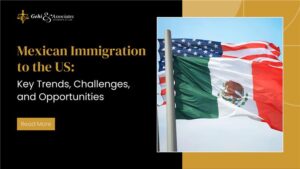
Mexican immigration to the US has long been a major part of the cultural, economic, and demographic fabric of the United States. In 2025, this topic remains as relevant as ever. Touching diverse areas like labor markets, immigration policies, economic ties, and cultural contributions.
However, the journey for Mexican immigrants is not without challenges. Shifting immigration policies, enforcement strategies, and social stigmas present significant hurdles. Let’s explore how Mexican immigrants handle the complexities of life in America. We’ll highlight their remarkable contributions and the support systems like Abogados Efectivos that empower them.
Mexican Immigration to the US; How the US Labor Market Adapting
Mexican immigration to the US has long been integral to the US labor market. Filling roles essential to sustaining industries and driving economic growth. In 2025, their contributions remain indispensable, particularly as the country grapples with labor shortages and an aging workforce.
From construction and agriculture to healthcare and service roles, their contributions are indispensable. Below, we explore how the market evolves to accommodate and integrate these skills.
Workforce Integration
Mexican immigrants have found roles in construction, agriculture, and service industries where labor shortages are pronounced. Recent data reveals that over 25% of construction workers in the US are foreign-born, with Mexicans comprising a significant portion. Agriculture, for example, depends heavily on Mexican labor. In 2023, over 320,000 undocumented workers were engaged in planting, harvesting, and processing crops.
Programs promoting vocational training and bilingual education are helping immigrants align their skills with market demands. For instance, regional initiatives in California and Texas aim to certify immigrant workers in trades like carpentry and electrical work. Aligning their skills with evolving market needs. These efforts ensure both workforce readiness and upward mobility for immigrant workers.
Job Market Mismatches
Many Mexican immigrants face job market mismatches, despite their high participation in essential sectors. This is due to a lack of recognition for their skills and credentials. Addressing this issue has become a priority in 2025.
States like Illinois are piloting “recognition of prior learning” programs. Allowing immigrants to demonstrate their expertise without undergoing lengthy re-education processes. Such measures are critical as industries like healthcare face acute labor shortages.
Economic Trends and Labor Needs
The aging US population and declining birth rates have placed tremendous pressure on the labor market. The US Bureau of Labor Statistics estimates that by 2036, the country will face a shortage of 135,000 healthcare workers. With immigrants filling approximately 15.6% of nursing roles and 28% of home health aide positions as of 2023.
In agriculture, the demand for labor continues to grow as fewer native-born Americans enter the field. Mexican immigrants remain the backbone of this industry, ensuring the US food supply chain operates smoothly. Additionally, the construction sector’s need for skilled labor is projected to rise sharply due to infrastructure expansion.
The economic contributions of Mexican immigrants go beyond fulfilling immediate labor needs. Studies suggest that immigrant workers drive innovation and productivity, particularly in industries that rely on diverse skill sets. Policymakers increasingly recognize the long-term benefits of fostering a stable and legally authorized immigrant workforce.
Tech-Driven Adaptation
Advancements in technology are reshaping traditional industries like agriculture and manufacturing. Creating challenges and opportunities for Mexican immigrants. Automated harvesting equipment and precision agriculture tools are becoming staples in farming. Thereby, requiring workers to adapt to tech-driven environments.
Cross-border initiatives like the US-Mexico Workforce Innovation Program equip immigrants with the technical skills to thrive in these evolving sectors. Training programs in states like Arizona and New Mexico focus on teaching immigrants to operate advanced machinery and use data-driven farming techniques. This ensures their continued relevance in the modern workforce.
Similarly, in manufacturing, Mexican immigrants are being trained to handle automation processes, such as operating robotic assembly lines. These programs enhance workforce integration and position immigrants as key players in industries undergoing rapid transformation.
Challenges in Policy Implementation
Despite their critical contributions, Mexican immigrants still face significant policy hurdles. Restrictive visa policies and lengthy processing times for work permits prevent many from participating fully in the labor market.
Furthermore, the lack of comprehensive immigration reform leaves many workers in legal limbo. Limiting their ability to advance in their careers or contribute more significantly to the economy. Advocates argue that addressing these barriers is essential.
How the US-Mexico Border Security Dynamic Shapes Mexican Immigration to the US
The US-Mexico border has long been a focal point of immigration policy and enforcement. Changes in security strategies, technological advancements, and cross-border collaborations are reshaping migration patterns. These efforts aim to strengthen border control and address security concerns. However, they also bring humanitarian challenges and unintended consequences, as policymakers strive to balance security and compassion.
Recently, there has been a reduction in Mexican immigration to the US involving crossing the border irregularly. Trends show a shift in migration demographics. Central Americans now represent a larger share of those attempting to cross, reflecting broader regional migration pressures.
Technology in Border Security
The US-Mexico border is becoming a testing ground for cutting-edge technologies designed to enhance border security. The deployment of drones, AI-powered surveillance, and facial recognition systems has revolutionized how the border is monitored. These tools provide real-time data and predictive analytics. They allow border patrol agents to identify and respond to unauthorized crossings more efficiently.
While these advancements improve operational capabilities, they raise critical ethical concerns. Privacy advocates question the use of surveillance technologies, particularly regarding their impact on civil liberties.
Humanitarian Implications
Stronger border enforcement policies frequently force migrants to take dangerous paths through remote areas. Extreme temperatures and lack of resources have led to an alarming number of fatalities. In 2024 alone, over 600 migrant deaths were recorded along the US-Mexico border.
These conditions also make migrants more vulnerable to exploitation by human traffickers. Smugglers often take advantage of stricter enforcement to charge higher fees while exposing individuals to abuse. Humanitarian organizations continue to advocate for policies prioritizing safe and orderly migration.
Cross-Border Collaboration
Bilateral cooperation on border security remains essential. Joint initiatives, including task forces targeting human trafficking and drug smuggling, have shown promise. Some movements have provided frameworks for fostering collaborative enforcement strategies. This includes; the US-Mexico High-Level Economic Dialogue (HLED) and agreements under the United States-Mexico-Canada Agreement (USMCA).
Programs like the Mérida Initiative have also been instrumental in providing resources for training Mexican border officials and modernizing equipment. However, experts argue that these collaborations must go beyond enforcement. Focusing on improving migration management systems and creating legal pathways to reduce irregular crossings.
Shifts in Migration Patterns
Patterns in Mexican immigration to the US have changed significantly over the past two decades. Between 2007 and 2022, the number of unauthorized Mexican immigrants in the US dropped by 34%, from 7.7 million to 5.1 million. Stricter enforcement policies, improvements in Mexico’s economy, and a decrease in its birthrate have contributed to this decline.
Meanwhile, migrants from Central America now make up the majority of irregular border crossings. Particularly countries like Guatemala, Honduras, and El Salvador. This shift reflects the impact of regional crises, including gang violence, political instability, and climate change-driven displacement.
Balancing Security and Humanity
Striking the right balance between border security and humane treatment remains one of the most pressing challenges. Advocates argue for policy reforms that address both security concerns and humanitarian needs. For instance, expanding access to temporary work visas and creating safer asylum processes reduces irregular crossings while preserving human dignity.
Additionally, investing in regional development initiatives in Mexico and Central America could address the root causes of migration. Thereby reducing the need for people to leave their homes in the first place. Policymakers must also consider the broader implications of enforcement measures. Working to align with the values of fairness, safety, and compassion.
Challenges to Mexican Immigration to the US Due to Changing US Immigration Policies
Mexican immigrants face mounting challenges. Especially as shifting immigration policies and enforcement strategies create complex legal and social landscapes. Impacting their legal status, safety, and livelihoods, introducing heightened uncertainty into their lives.
Increased Deportation Risks
Stricter enforcement measures in 2025 have escalated deportation risks, particularly for undocumented Mexican immigrants. As of mid-2023, the US deported approximately 5.1 million Mexican nationals. A 34% decline from its 2007 peak but still a significant share of total removals.
However, deportation risks extend beyond those crossing the border. Interior enforcement has intensified, leading to workplace raids and arrests in immigrant-dense communities. Immigrants in “legal limbo” those with pending asylum applications or expired temporary protections face heightened vulnerability. This constant threat disrupts families and instills widespread fear, affecting community cohesion.
Barriers to Legal Pathways
Obtaining legal status remains a steep uphill battle for many Mexican immigrants. Processing backlogs within the USCIS reached unprecedented levels in 2023, with an estimated 10 million cases pending. Family-sponsored green cards, a common pathway for Mexican immigrants, can take upwards of 10 years due to country-specific caps.
Furthermore, work-based visas are often inaccessible to low-wage immigrants in sectors like agriculture and construction. Policies prioritizing “high-skilled” labor largely exclude Mexican immigrants despite their indispensable contributions to key industries. These barriers perpetuate cycles of legal uncertainty, restricting their ability to participate in the economy fully.
Advocacy and Legal Support
Advocacy groups and legal service providers have stepped up to fill critical gaps in response to these challenges. Queens Immigration attorney provides essential legal aid to Mexican immigrants in Queens and beyond. Helping them through complex cases involving asylum, family sponsorship, and deportation defense.
Local groups are also mobilizing resources to support vulnerable immigrants. Their initiatives include know-your-rights workshops, legal clinics, and mental health services. These efforts empower individuals to fight for their rights while advocating for systemic policy reforms.
Want to understand how long it will take to immigrate? Then read this article.
Cultural and Entrepreneurial Contributions of Mexican immigration to the US
Mexican immigrants have profoundly shaped American cities, contributing to their vibrancy, resilience, and growth. Their influence permeates cultural traditions, entrepreneurial ventures, and community development.
Culinary Influence
Mexican cuisine has become an integral part of the American food culture, transforming dining habits from coast to coast. According to recent surveys, Mexican food ranks as one of the most popular ethnic cuisines in the United States. Over 60,000 Mexican restaurants are operating nationwide. In cities like New York, taco trucks and taquerias are as iconic as any local landmark.
Small Business Growth
Mexican immigrants are at the forefront of small business ownership, demonstrating a remarkable entrepreneurial spirit. In 2023, they accounted for 10% of immigrant-owned businesses in the US. These businesses create jobs and act as economic engines within local communities.
Revitalizing Urban Areas
Mexican immigrant communities often breathe new life into economically stagnant or underserved areas. Vibrant cultural festivals, such as Cinco de Mayo celebrations or Día de los Muertos parades, draw thousands of participants and spectators annually. This creates a surge in local economic activity.
Let’s Build a Brighter Future Together
Mexican immigration to the US, particularly in areas like Queens, represents a complex yet deeply enriching phenomenon. From labor market contributions to cultural innovations, Mexican immigrants are integral to the nation’s progress. But behind every success story are challenges, legal uncertainties, policy shifts, and the struggle for dignity and belonging.
At Queens Immigration Attorney we understand that immigration is about protecting dreams and securing a future filled with opportunity. Start by scheduling a free consultation today!




